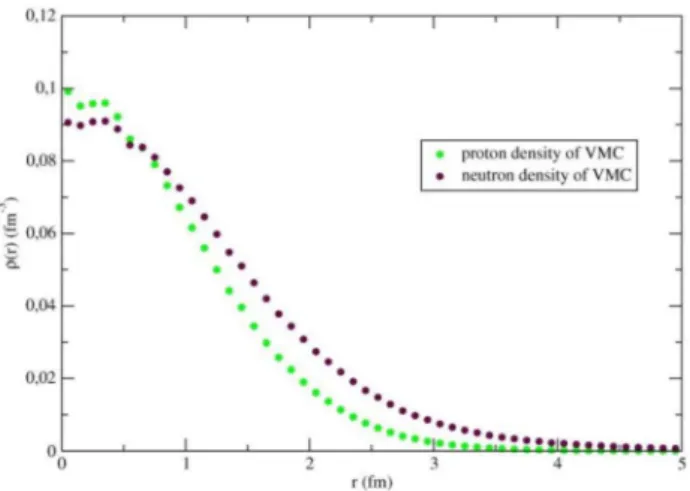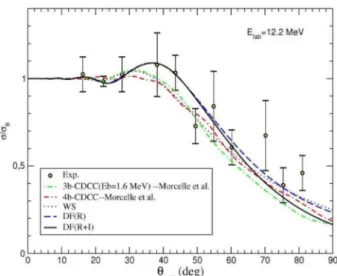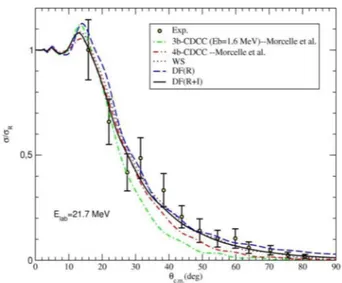Eastern Anatolian Journal of Science
Volume II, Issue II, 49-52 Eastern Anatolian Journal of Science
Abstract
In the present study, the elastic scattering angular distribution of 6He on 58Ni is investigated at incident
energies of 12.2, 16.5 and 21.7 MeV. In the calculations, three different nuclear potentials obtained with the phenomenological and the microscopic approaches based on the optical model are used. Firstly, the phenomenological Woods-Saxon potential for both real and imaginary parts of nuclear potential is considered. Secondly, the double folding potential for the real part together with an imaginary part in Woods-Saxon form is applied. Finally, the real and imaginary parts of nuclear potential are assumed as the folding potentials. The elastic scattering results of all the models are compared with the literature results as well as the experimental data. The results are in agreement with the experimental data.
PACS numbers: 24.10.Ht, 25.60.Bx
Keywords: Exotic nuclei interactions; elastic scattering; optical model; double folding model.
1. Introduction
Exotic nuclei have become one of the most interesting research fields in the nuclear physics. They have shown different features compared to the stable nuclei. For example, they have low binding energy, large rms value and different density distributions. In this sense, the 6He
nucleus which consists of a tightly bound core ( ) and valence nucleons (n + n) is one of the most investigated exotic nuclei. With this goal, a lot of both theoretical and experimental studies have been carried out (AYGUN et al. 2010, 2012, 2013; AYGUN, 2013; AYGUN and BOZTOSUN, 2014; ZHUKOV et al. 1993).
Accepted Date: 20.09.2016 Corresponding author:
, PhD Bitlis Eren University,
Department of Physics, Bitlis, Turkey E-mail: murata.25@gmail.com
6He is still one of the hot topics of nuclear physics.
Recently, MORCELLE et al. (2014) measured the elastic scattering angular distributions of the 6He + 58Ni reaction
at Elab=12.2, 16.5 and 21.7 MeV. They investigated the
experimental data by using three-body Continuum Discretized Coupled Channels (CDCC) and four-body CDCC calculations. They reported that four-body CDCC calculations show a very well agreement with the experimental data. In the present paper, our aim is to theoretically investigate new measured elastic scattering angular distributions of the 6He + 58Ni reaction with
different nuclear potentials. For this, we use both the phenomenological and the microscopic models based on the optical model (OM). All the theoretical results are compared with the results of the previous study (MORCELLE et al. 2014) as well as the experimental data.
In the next Section, the presentation of theoretical formalism is made. The theoretical results are given in Section III. Section IV is devoted to our summary and conclusions.
Within the framework of the OM, the total potential can be written as the sum of nuclear and Coulomb potentials given by
(1)
where the Coulomb potential (SATCHLER, 1983) due to a charge ZPe interacting with a charge ZTe distributed
uniformly over a sphere of radius Rc is
(2)
(3)
Optical Model Analysis of Elastic Scattering of
6He +
58Ni Reaction
1,* 1 2 3 4
1Bitlis Eren University, Department of Physics, Bitlis, Turkey
2Vocational School of Technical Sciences, Bitlis Eren University, Bitlis, Turkey 3
50 Vol. II, Issue II, 2016
where Rc is the Coulomb radius, taken as 1.25(AP1/3
+AT1/3) fm in the calculations and ZP and ZT denote the
charges of the projectile P and the target nuclei T, respectively.
A. Phenomenological approach
For phenomenological analysis based on the OM, the real and imaginary potentials are taken as the Woods-Saxon (WS) type in the following form
(4)
where Ri = ri (AP1/3 +AT1/3) (i = V or W), where AP and AT
are the masses of projectile and target nuclei and rV and rW
are the radius parameters of the real and imaginary parts of the nuclear potential, respectively. The two equations which give the depth-variations of the real and imaginary parts have been reported by KUCUK et al. (2009). In our work, first nuclear potential is obtained by using these equations and is attributed as WS.
B. Double folding model
The double folding model (DFM) is applied to obtain the real part of the optical potential. The DFM is acquired with the nuclear matter distributions of both projectile and target nuclei together with an effective nucleon-nucleon interaction potential ( NN). In this way, the double folding
(DF) potential is given by
(5) where P(r1) and T(r2) are the nuclear matter densities of
projectile and target nuclei, respectively. For the projectile, we have used the Variational Monte Carlo (VMC) density distribution which is obtained from the VMC calculations using the Argonne v18 (AV18) two-nucleon and Urbana X three-two-nucleon potentials
(AV18+UX). The VMC density of 6He given in Fig. 1 is
taken from Ref. (VMC). However, the density of the 58Ni
has been assumed as two-parameter Fermi (2pF) density distribution in the following form (FARID and HASSANAIN, 2000)
, (6) where 0, c and z parameters are 0.172, 4.094 and 0.54,
respectively.
The effective nucleon-nucleon interaction, NN, is
integrated over both density distributions. We have used the M3Y nucleon-nucleon (Michigan 3 Yukawa) realistic interaction given by
Figure 1. Proton and neutron density distributions in linear scale for 6He nucleus.
(7) where J00(E) represents the exchange term and can be
expressed as
(8) This potential is evaluated as DF(R) in the present work.
For the last nuclear potential, the real and imaginary parts are assumed as the folding potentials which have the same shape and different strengths. With this goal, the imaginary potential is applied as the folded potential multiplied by a normalization factor NI. Thus, the 6He + 58Ni reaction can be expressed as
(9)
This potential (Eq. 9) is denoted as DF(R+I) in our study. The codes FRESCO (THOMPSON, 1988) and DFPOT (COOK, 1982) have been applied for all the calculations.
The angular distributions of the elastic scattering of the 6He + 58Ni reaction have been investigated for three
different nuclear potentials at Elab=12.2, 16.5 and 21.7
MeV. For this, firstly, we have obtained the phenomenological potential (WS) by using the equations reported by Ref. (KUCUK et al. 2009). Secondly, we have conducted the folding model calculations for the real potential based on the OM. In this respect, the imaginary potential has been taken as the volume WS potential. Finally, both the real and imaginary parts of the optical potential have been assumed as the folding potentials.
Vol. II, Issue II, 2016 Optical Model Analysis of Elastic Scattering of 6He + 58Ni Reaction 51
Thus, both potential are in the same shape and different strengths. While the theoretical calculations of the phenomenological model and the folding model have been performed, the values of the V0, W0, rv, rw, av and aw
potential parameters have been researched to obtain a good agreement fit with the experimental data. All the parameters have been listed in Tables I, II and III.
Table 1. Optical potential parameters used for the WS potential analysis of the 6He + 58Ni reaction at various energies.
Table 2. Optical potential parameters obtained from the DF(R) potential analysis of 6He + 58Ni reaction.
Table 3. The normalization factors (NR and NI) for real and
imaginary parts used in the DF(R+I) potential analysis of 6He + 58Ni reaction.
The theoretical results achieved by using the WS, DF(R) and DF(R+I) potentials have been plotted in Figs. 2, 3 and 4 as compared with each other as well as the experimental data. We have observed that the DF(R+I) results are better than the results of DF(R) and WS potentials in general. However, we have noticed that the changes in the NR and NI values are large. Then, we have
compared our results with the literature results (MORCELLE et al. 2014). As seen from Figs. 2, 3 and 4, the behavior of the our results are similar to 4b-CDCC results and our results are better than 3b-CDCC (Eb=1.6 MeV) results. Finally, we have given the cross-sections of all the nuclear potentials analyzed with this study. We have observed that the DF(R+I) cross-sections are bigger than the cross-sections of the other potentials in general.
Figure 2. The elastic scattering angular distributions of the 6He + 58Ni reaction obtained from the optical model calculations
employing WS, DF(R) and DF(R+I) potentials in comparison with the literature at 12.2 MeV.
Figure 3. Same as in Fig. 2, but for 16.5 MeV.
Potential Elab V rv av W rw aw
Type (MeV) (MeV) (fm) (fm) (MeV) (fm) (fm) (mb)
12.2 133.224 0.90 0.70 7.643 1.50 0.70 1106.6 WS 16.5 136.019 0.90 0.70 6.998 1.50 0.70 1632.8 21.7 139.399 0.90 0.70 6.218 1.50 0.70 1940.8 Potential Elab NR NI Type (MeV) (mb) 12.2 0.55 0.35 908.4 DF(R + I) 16.5 0.12 1.25 1646.6 21.7 0.35 1.50 2100.4 Potential Elab NR W rw aw
Type (MeV) (MeV) (fm) (fm) (mb)
12.2 0.63 10.0 1.39 0.5 822.7
DF(R) 16.5 0.57 14.5 1.39 0.5 1334.4
52 Vol. II, Issue II, 2016
Figure 4. Same as in Fig. 2, but for 21.7 MeV. In the present work, we have also gotten a simple equation for the imaginary potential varying with incident energy of the 6He exotic nucleus. This equation is written
as
(10) where Elab is the incident energy of the 6He nucleus.
-experimental data and three-body and four-body CDCC results of the 6He + 58Ni reaction.
AYGUN, M., KUCUK, Y., BOZTOSUN I. and IBRAHEEM, A. A. (2010), Microscopic few-body and gaussian-shaped density distributions for the analysis of the 6He exotic nucleus with
different target nuclei. Nuclear Physics, 848, 245-259.
AYGUN, M., BOZTO A
study on the Fresnel diffraction of 6He by means
of different microscopic density distributions. Physics of Atomic Nuclei, 75, 963-968.
AYGUN, M., BOZTOSUN, I. and RUSEK, K. (2013), Parametrized form of the dynamic polarization potential for the 6He + 208Pb interaction. Modern Physics Letters A, 28, 1350112.
AYGUN, M. (2013), A theoretical study on 120Sn(6He, 6He)120Sn elastic scattering. Annals of Nuclear
Energy, 51, 1-4.
AYGUN, M. and BOZTOSUN, I. (2014), An extended
analysis of the elastic scattering of
6Li(6He,6He)6Li system at 17.9 MeV. Few-Body
Systems, 55, 203-209.
COOK, J. (1982), DFPOT - A program for the calculation of double folded potentials. Computer Physics Communications, 25, 125-139.
FARID, M. EL-AZAB and HASSANAIN, M. A. (2000), Density-independent folding analysis of the 6,7Li elastic scattering at intermediate energies. Nuclear Physics A, 678, 39-75.
KUCUK, Y., BOZTOSUN, I. and TOPEL, T. (2009), Global optical potential for the elastic scattering of 6He at low energies. Physical Review C, 80, 054602.
-FARIA P. N., MENDES JUNIOR, D. R.,
MORO, A. M., GASQUES, L. R.,
LEISTENSCHNEIDER, E., PAMPA
CONDORI, R., SCARDUELLI, V., MORAIS, M. C., BARIONI, A., ZAMORA, J. C., and SHORTO, J. M. B. (2014), Four-body effects in the 6He + 58Ni scattering. Physics Letters B, 732, 228-232.
SATCHLER, G. R. (1983), Direct Nuclear Reactions (Oxford University Press, Oxford).
THOMPSON, I. J. (1988), Coupled reaction channels calculations in nuclear physics. Computer Physics Reports, 7, 167-212.
VMC, Variational Monte Carlo density distribution, http://www.phy.anl.gov/theory/research/density/ ZHUKOV, M. V., DANILIN, B. V., FEDOROV, D. V.,
BANG, J. M., THOMPSON, I. J. and VAAGEN, J. S. (1993), Bound state properties of Borromean halo nuclei: 6He and 11Li Review.


